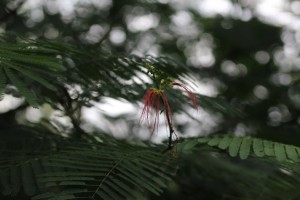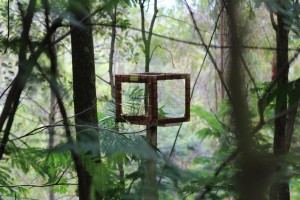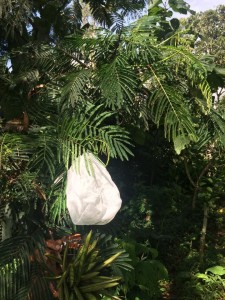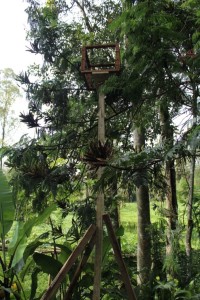Alongside measuring energetics of the Javan slow loris, a big part of my research is also investigating their potential role as pollinators—it is this research that lead to my interest in all pollinators of a specific flora species in Cipaganti.
About one-third of the slow loris diet is consumed from floral nectars. Here in Cipaganti, one of the most frequent feeding behaviours we see is lorises feeding on an inflorescence commonly known as “fairy dusters” [Calliandra calothrysus] and locally known in Bahasa Indonesian as “kaliandra merah”. This species is a legume, and also a nitrogen-fixate, as you may have read in a previous blog by our research coordinator Robert O’Hagan.

Pollination studies can be quite tricky, as there are so many influential factors to consider: insects, wind speed and direction, sun direction, precipitation, variation between day and night, etc. One of the biggest obstacles I have come across with this study, has been control experiments. There are two different ways I am doing this – by secluding potential pollinators and also, artificial pollination.

Just a few of the methods I am using include pollen bags, bat and bird-proof pollination boxes, trees that lorises can not access, and last but not least, tree follows! A tree-follow literally means we sit outside a single tree for hours, noting what species interact with it, because interaction frequency can functionally link species to pollination. Starting in May, we will also start net-sampling of invertebrates to determine invertebrate—flower interactions. Combining this with our bimonthly monitoring on the fruiting and flowering stages of trees, we can look for evidence of pollen transport and see how different species respond to changing floral patterns. This can also help us to identify species and their abundance in the region.

Setting up the pollination boxes has proved to be most time consuming for us. For a few weeks now, Adin and I have been building these boxes, while Aconk has been getting the permission of farmers and land owners to set them up, and now we have finally finished building them and set them up in the forest. This involved us carrying all of the boxes and lumber up the mountain, and nailing a stand in place at ~6 meters in height – where most kaliandra flowers hang. It was an exhausting day, but it was so rewarding to see them all set up!
Farmers have planted kaliandra throughout the area, because they are known to improve soil richness. So, if we find that lorises indeed are pollinators, it would mean a mutualistic relationship between lorises, kaliandra and farmer’s crop yields. There is so much to be said about Calliandra and all its benefits. Sharing these findings throughout loris ranging areas, we could increase awareness of slow lorises and the benefits they have to both farmers and their ecosystems.

- Katie Reinhardt, PhD Student
